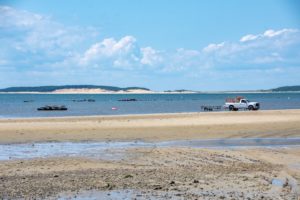WELLFLEET — More than two years ago, town meeting voters bought 254.5 acres of shellfish flats for $2 million, with half the money donated by select board member Helen Miranda Wilson, the other half coming from taxpayers.
The select board has scheduled a virtual public hearing for Monday, Aug. 16 at 7 p.m., at which town officials will begin to plan what to do with the tidal land.
In April 2019, voters agreed to take the rare step of buying the flats from Indian Neck to Blackfish Creek. The reason, according to advocates of the purchase, was to preserve one-third of the town’s shellfishing grounds from being sold to deep-pocketed corporations or other “entities.”

The flats were owned by the HDYLTA Realty Trust — four local businessmen who had purchased them in 1999 for $25,000. (HDYLTA stands for “How Do You Like Them Apples.”) Their lawyer, Ed Englander of Newton, claimed that the flats were worth more than $4 million and suggested that his clients might sell to the highest bidder. The initial offer to the town was for $3.4 million.
There are 24 shellfish grants on that property, comprising about 75 of the 254 acres, Shellfish Constable Nancy Civetta said. The rest is saltmarsh, areas for wild shellfish harvesting, and over one mile of beach, extending from Burton Baker Beach to around the tip of Field Point.
Since the town bought the flats, however, there has been no discussion of how to manage this unique town asset. Attorney Englander, who specializes in beach rights, said that aquaculture farms in Massachusetts are usually privately owned. So, this is a situation without much precedent.
Harbormaster Will Sullivan said he and Civetta have been asking town leaders to set policy for the town’s flats for a while. “When you buy open space, you talk about what to do with it,” said Sullivan. “This was purchased by all the taxpayers. It belongs to the people.”
That means not just shellfish grant holders, but the wild shellfish pickers, upland property owners, and boaters.
Though the flats were ostensibly purchased to protect the local shellfishing industry from wealthy bidders, boat owners need space. Alfred Pickard, whose Wellfleet Marine services most of the moorings in town, said he has trouble finding new places to put his customers’ moorings. Shellfishing gear, especially when it is stacked high, is hazardous to navigation, Pickard added.
Wellfleet Charters owner Kevin Coakley, who takes people fishing from the harbor, agrees that the interests of recreational boaters need to be considered. “I think there needs to be balance, and right now there is no balance,” Coakley said.
Recreational boating has exploded during the past year, Sullivan said. Wellfleet Harbor’s federal channel was recently dredged, and the pandemic has driven interest in outdoor activities.
Bay Sails Marine currently has no motors and no vessels in stock, said Kendra Lindberg, office manager at the Wellfleet boat dealership.
“Everything is gone,” Lindberg said, due to increased enthusiasm for boating and a shortage of materials in the supply chain.
Wild pickers, the shellfishermen who collect and sell the wild oysters, also have rights, Sullivan said. They use a portion of the HDYLTA flats. Other areas of the flats that are not now productive may one day become new aquaculture grants, Sullivan said.
“There is not a lot of availability for new grants, but there is some,” said Sullivan. “What do we want to do with that?”
Then there are the upland property owners. If you have an unbroken row of grants along the shoreline, how do upland owners get access to the water, Sullivan asked.
Some of these questions reached the shellfish advisory board (SAB) in early June, when its members took a vote on whether to recommend a moratorium on new shellfish grants or grant extensions in the harbor. The moratorium proposal failed on a three-to-three tie vote.
Pickard said nothing else should change out there until there is a plan.
“If you don’t have a plan, why keep granting extensions?” he asked. “I am not going to say ‘moratorium’ — just get a plan.”
Will Berrio, a shellfish grant holder in the HDYLTA flats, said he sees nothing wrong with extensions that just square off boundaries that confuse boaters. That is how the three people who recently requested grant extensions described their reason for seeking additional acres. Shea Murphy, Pat Winslow, and select board member Mike DeVasto, who all have grants in the Indian Neck area, requested extensions that together total 3.75 acres, Civetta told the SAB. She has reviewed all three and said they make sense, she said. No other applications for extensions have come before her, she added.
Civetta would not comment on whether she would like a moratorium or even a planning effort.
But Sullivan said, “We want guidance. Clarity and planning in this town are really needed.”



